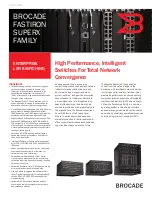
viii
Cisco CRS Carrier Routing System 4-Slot Line Card Chassis Installation Guide
OL-10971-10
Preface
•
Chapter 1, “Overview,”
provides an introduction to the various line card chassis systems and
components. This chapter also provides the recommended sequence of tasks for installing all the
major components of the Cisco CRS 4-slot line card chassis.
•
Chapter 2, “Installing and Removing Power Components,”
details how to bring power to and install
power components in the line card chassis, including the AC and DC power shelves power supplies,
and alarm module.
•
Chapter 3, “Installing and Removing Air Circulation Components,”
describes how to install the fan
trays and air filters.
•
Chapter 4, “Installing and Removing SFCs, RPs, MSCs, FPs, LSPs, PLIMs, and Associated
Components,”
provides instructions on how to install various cards, including PLIMs, switch fabric
cards, and modular services cards.
•
Chapter 5, “Installing and Removing the Doors and Grille,”
documents how to install and remove
the optional exterior components, the front doors and grille.
•
Appendix A, “Cisco CRS 4-Slot Line Card Chassis System Specifications,”
lists the technical
specifications for the Cisco CRS 4-slot line card chassis.
Document Conventions
This guide uses the convention where the symbol ^ represents the key labeled
Control
. For example, the
key combination
^
z
means hold down the
Control
key while you press the
z
key.
Command descriptions use these conventions:
•
Examples that contain system prompts denote interactive sessions, indicating the commands that
you should enter at the prompt. The system prompt indicates the current level of the EXEC
command interpreter. For example, the prompt
router>
indicates that you should be at the
user
level, and the prompt
router#
indicates that you should be at the
privileged
level. Access to the
privileged level usually requires a password. Refer to the related software configuration and
reference documentation listed in
“Related Documentation”
for additional information.
•
Commands and keywords are in
boldface
font.
•
Arguments for which you supply values are in
italic
font.
•
Elements in square brackets ([ ]) are optional.
•
Alternative but required keywords are grouped in braces ({}) and separated by vertical bars (|).
Examples use these conventions:
•
Terminal sessions and sample console screen displays are in
screen
font.
•
Information you enter is in
boldface screen
font.
•
Nonprinting characters, such as passwords, are in angle brackets (< >).
•
Default responses to system prompts are in square brackets ([]).
•
Exclamation points (!) at the beginning of a line indicate a comment line.
Note
Means
reader take note
. Notes contain helpful suggestions or references to materials not contained in
this manual.



































